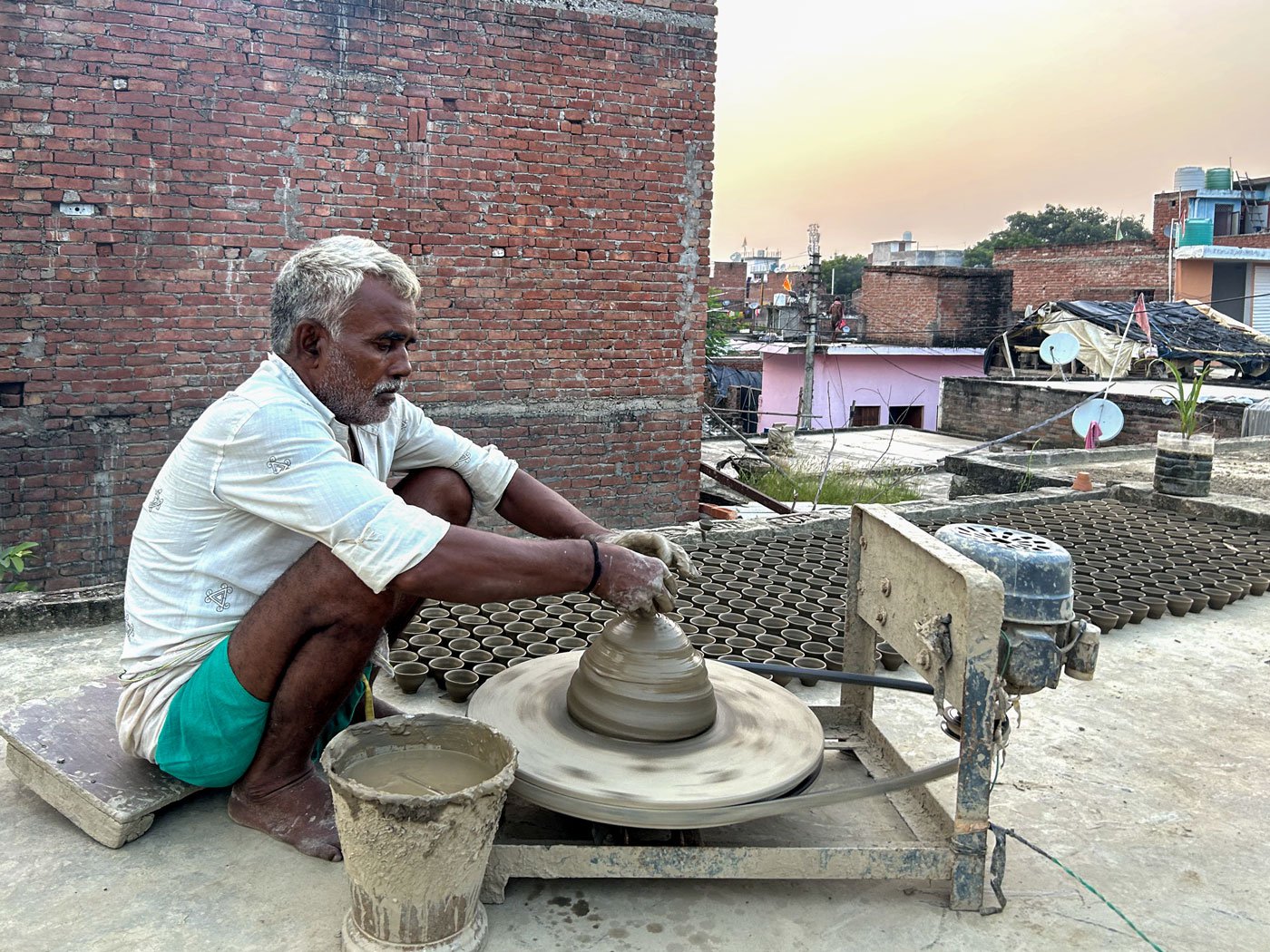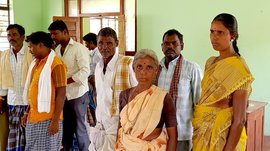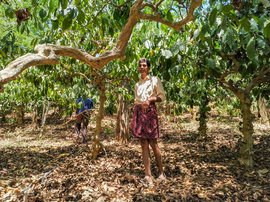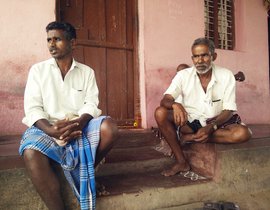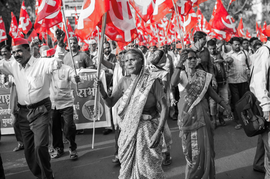Maya Prajapati is sitting on a charpoy outside a run-down brick shack. She is relaxing after a long day spent creating clay artefacts.
She proudly points inside the room and says, "I've made it all." In the corner of the dimly lit room are hundreds of different-sized diyas (lamps) and pots, while dolls and idols line the floor.
Maya, in her early forties, explains, "It's all in preparation for Diwali. We work hard all year round just for that festive period."
In Chinhat's Kumharon ka mohalla (potters' community), a block on the outskirts of Lucknow city in Uttar Pradesh, Maya is one of the few skilled female workers in the area. "Pottery is mainly a man's livelihood here. Women help, but they have other household work to do. For me, though, it's different."

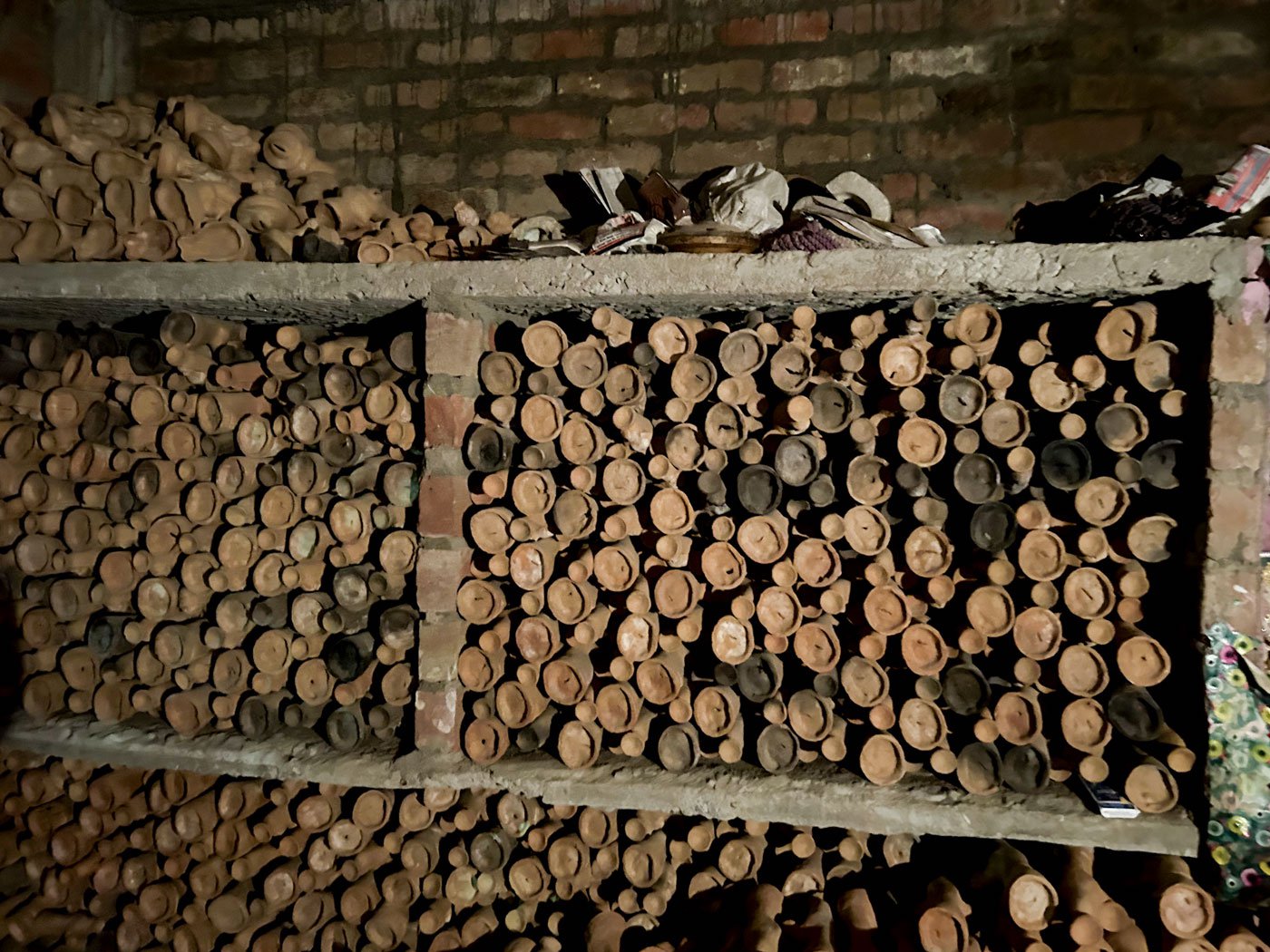
Left: Shiva Bansal (yellow t-shirt) sitting with Maya Prajapati and her two children. Both of them work as potters in Lucknow's Chinhat block. Right: The storeroom where Maya keeps all her creations
After Maya Prajapati's husband passed away a few years ago, she had to take on her husband's duties to keep herself and her two children fed. "My husband died recently, and now I'm the breadwinner of the house; this is how I keep our stomachs full. I can still sustain us because I know how to do this."
Even though she took over production only recently, Maya has been moulding clay ever since she was a child. "I started making dolls, idols, and many other decorative clay items when I was a kid, probably when I was 6 or 7 because everyone in our house did it." Twenty years ago, she got married and moved to Chinhat. "Today, I can make the usual: pots, glasses and diyas, but I enjoy making dolls and moortis [idols of gods] the most."
"Making them requires a lot of patience, which I have mastered over the years. I have moulds for different items. I put the clay in them, and then when it dries, I paint them. Painting is the hardest bit, and it also takes time."
Maya says Diwali is when she makes the most sales; the entire year is a preparation for the festival. "Diwali is a great time to sell these decorative pieces; we sell hundreds in the Chinhat bazaar. Sometimes, the vyapaaris [merchants] come to our houses to buy from us. "The sale is unpredictable for the rest of the year, so we must save up whatever we make during Diwali."
While the money from pottery is nowhere near the effort put into it, Maya is thankful for their ancestral craft because she says it has been her saving grace in trying times.

Maya Prajapati showing the dolls made by her in her house
In another part of the mohalla , an old speaker blares up-tempo Punjabi beats, drowning out the sounds of a sizzling fire and a whirring potter's wheel.
"My sons like to listen to something while we work," says Deshraj, laughing. For the last 40 years, work for Deshraj has been creating some of the finest clay artefacts, including pots. The music, he says, offers a bit of excitement to an otherwise monotonous day.
The master craftsman methodically moves his tired but skilled fingers, moulding wet clay to create pot after pot on the rotating wheel. Once each pot is complete, he carefully arranges them in forty neat rows on the terrace of his partially constructed home.
Meanwhile, smoke billows from the bhatti (furnace) in the compound, where pots from the previous night are being fired. Plumes of smoke fill their home, but Deshraj's family members who were at home that afternoon (two sons, one of their wives and two small children) appear uninterrupted and unbothered by the smoke's intrusion. They continue to go about with their chores.
"I can make pretty much anything: pots, cups, diyas, plates and other decorative items," he adds, "These days, I'm making kujjis [little pots used in pujas], they are used in Chhath puja." Chhath puja is a Hindu festival dedicated to worshipping the sun god, Lord Surya, and performed typically in October or November.
"I make around 1000 to 1200 items in a day and then sell them for 15 rupees a dozen; sometimes, if the buyer bargains, then we also sell it for 10 rupees a dozen," he says.

Deshraj making pots on his terrace
The little earthen artefacts, which sell for just a little over a rupee, take their final shape after a long and laborious process. It starts at four in the morning, Deshraj says, when his son leaves for Lolai village a few kilometres away to dig clay out of a pond. Only the men in his family do this work, he says. His son then brings this back to the house in an e-rickshaw by 7 am at the latest.
The clay is spread out in the sun to dry. The next step involves crushing the dried mounds and removing rocks through sieving. The clay is made into a dough-like consistency, the father says. Deshraj starts making the pots on the wheel only around midday. Once they finish, everything is placed in the kiln overnight.
Deshraj wipes the sweat off his forehead with the back of his hand. He says, "The whole process of pottery making has become easier over time, but the expenses have also increased." He then stands up from his squatting position to stretch his aching legs.
"I now use a motorised potter's wheel. Earlier, I had a manual one, which I had to rotate with my hand continuously. As for the transport of the clay from the pond, we used to do that on our heads, but now we use the e-rickshaw to get the clay from Lolai village (about 5 kilometres away)."


Left: The bhatti (kiln) outside the Kumharon ka mohalla in the village. Right: A kiln inside Deshraj’s house
That is not without its fair share of expenses. The family's monthly electricity bill is around Rs 2500, and the e-rickshaw adds another Rs 500 per trip. "Add in our food, gas and other expenses, and in the end, we are left with nothing," says a disheartened Deshraj.
Deshraj shrugs when asked if he's considered taking on a different job. "This is all I know; this is who I am. I am a kumhar; I don't know how to be anything else." He points to the other potters in the locality, their bobbing heads visible from his terrace, and says, "We are all related somehow; we all come from the same family. One of our forefathers was the original kumhar ; we are his descendants."
The locality is home to about 30 families, says Deshraj. "We live like one big family. In my 55 years of life, I have seen my grandfather and then my father making pots, then I did it, and now my son does the same."
When 14-year-old Shiva Bansal's father died a few years ago, his mother started drinking a lot, leaving the youngster to fend for himself. "Pottery is what gave me hope," he says.
The youngster had to drop out of school earlier this year to work. "All the people in this village have helped me. I've learnt things from everyone," Shiva says. "I'm still not an expert, but I can make most items. Apart from making the items, I assist the kumhars in carrying the clay from the pond and even help them load the furnace; they pay me what they can for it," says Shiva, who now lives alone in his father's house.

Left: The view from Deshraj’s terrace showing the clay artefacts drying on terraces of other houses in the mohalla . Right: Pots made by Hiralal Prajapati
Despite his troubled family life, Shiva says he has never felt alone in the kumhar village. "There is so much love between us; everyone knows me and cares for me. Some offer food, some offer work."
He walks over to his mentor, Hiralal Prajapati's house. "Chacha is so good at this, maybe one of the best here," Shiva says, "I like learning from him." Hiralal laughs and pats Shiva's back, "I've just been doing it for too long. We are not educated, so we have all done this since we were little."
Hiralal says along with his usual work, he also visits a school in Lucknow and teaches pottery classes to students. "I get to take my creativity to another level there. We make things we haven't made before when they have their annual exhibition. This year, it was a fountain, among other things! I like sharing my art with students."
"I haven't been to many places but the school staff told me that some of my artefacts from the exhibition were bought by people who live in Australia." He gleams and repeats it with disbelief, "My art is in Australia..."
